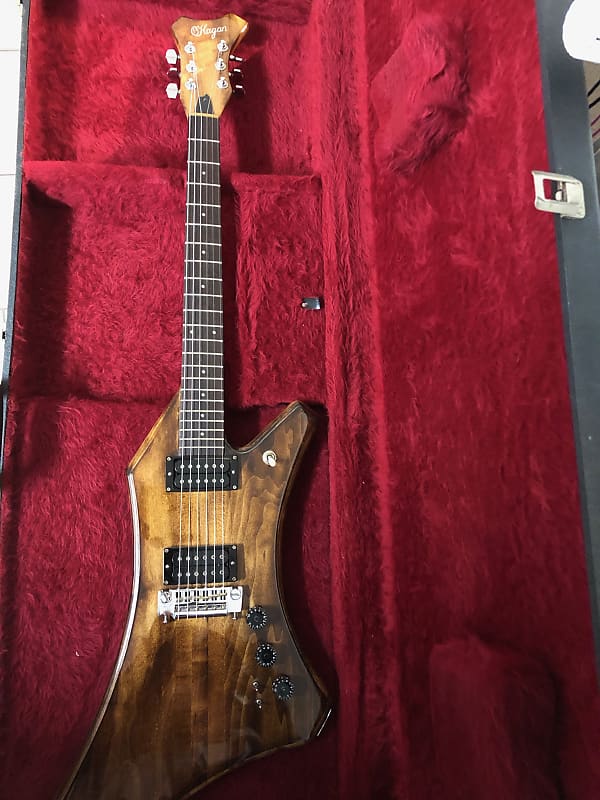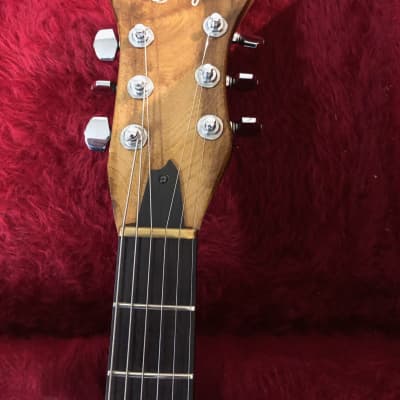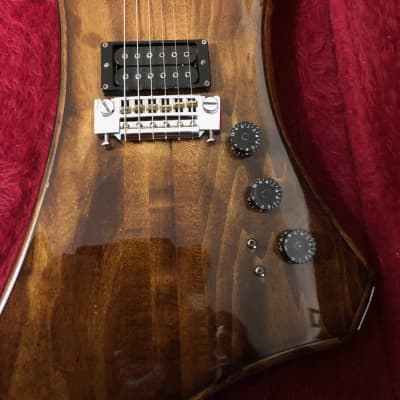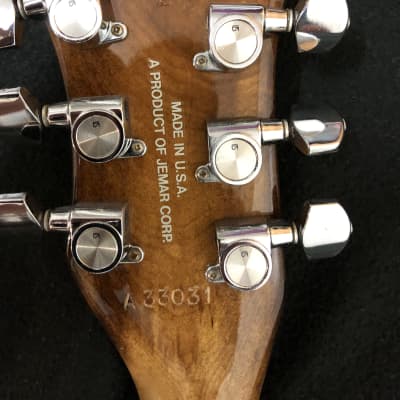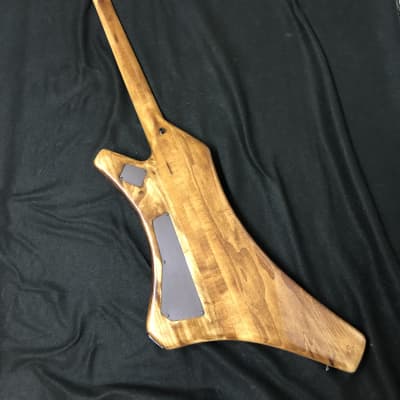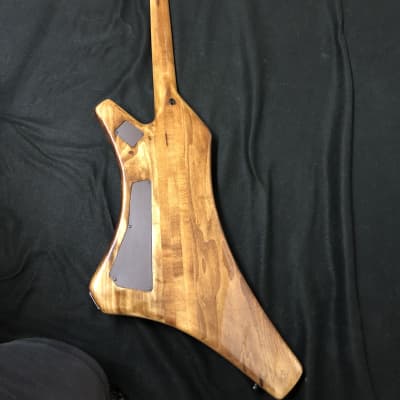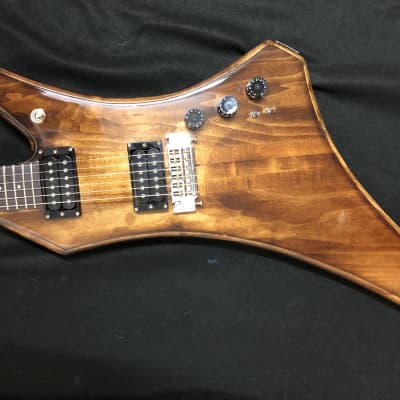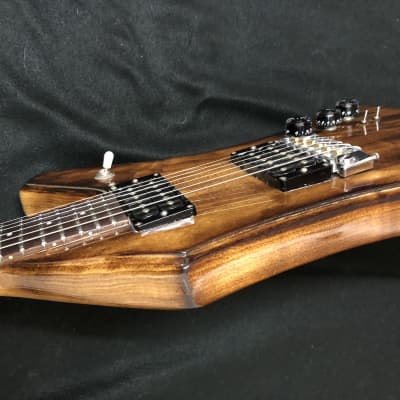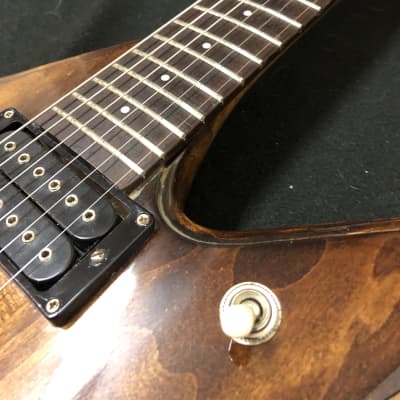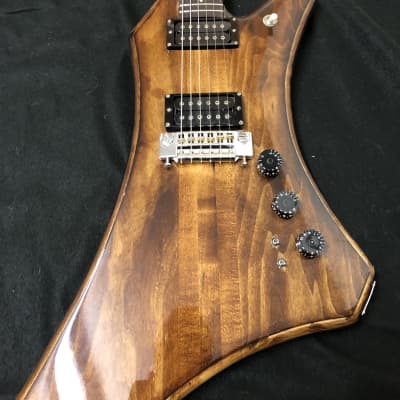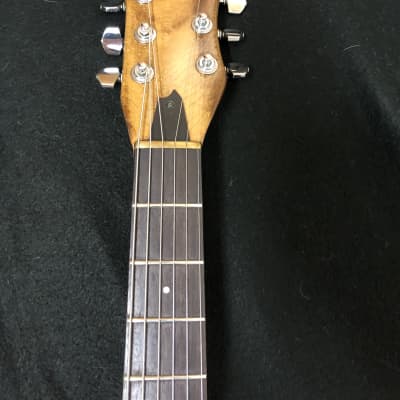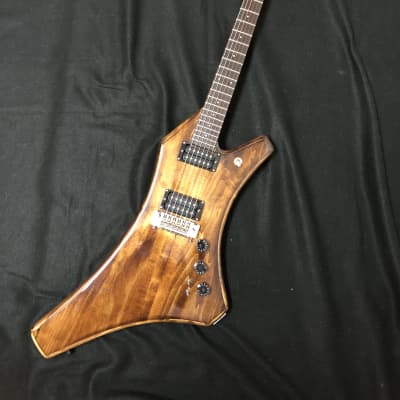O’HAGAN SHARK
Vintage O'HAGAN SHARK HANDMADE USA CUSTOM GUITAR 1983 EXTREMELY RARE!
SN: A33031
- CONDITION IS VERY GOOD.Minor Scuffs,scratches and wear All electronics have been updated with new pots and wiring and work great and sound is VERY STRONG.
- PLAYABILITY: This guitar is a dream to play. It is well balanced and the neck is a medium radius that is a perfect cross between an LP and Strat. And it is smooth to play and without a heel you can reach every note. Great frets. AND THIS GUITAR IS EXTREMELY EASY TO PLAY SITTING DOWN.
- SOUND: Thanks to the through body MAPLE laminate NECK and the HOT LOUD SCHALLER HUM BUCKER pickups this is a real rock and roll guitar with sustain that keeps going after you put it on the stand and leave the MODEL: "THE SHARK"
- BODY WOOD: SOLID MAPLE (Wings on through body neck)
- FINISH: Natural, Clear.
- TOP: "German" Carve (beveled) around body.
- NECK: Through body without heel ("heel less" allowing more access to strings).
- HEADSTOCK: "German Carve"beveled. Aysmmetrical.
- NECK is MAPLE/WALNUT LAMINATE (three pieces)
- FRETBOARD is BRAZILIAN ROSEWOOD.
- FRETS: 22 Jumbo
- PICKUPS: TWO (2) RARE SHALLER HUMBUCKERS
- CONTROLS: A three-way selector switch,( 2) volume & one tone knobs
- (2) Single Throw switches aftermarket installed. I beleive they are for phase in/out
- TUNERS: GOTOH SEALED CHROME
- BRIDGE: SCHALLER-Wrap around "FINETUNE".
- Brass Nut and Brass String Sadles
O'HAGAN GUITARS BUILT BY JERRY O'HAGAN.
The first O'Hagan guitar to be made was the Shark, a sort of Explorer design which, as O'Hagan points out, is much more comfortable to play than the Gibson when you're sitting down. It was designed by O'Hagan and debuted in 1979. Like all subsequent O'Hagan guitars, these were essentially handmade instruments made of maple and walnut and featuring neck-through construction, which O'Hagan preferred for its sustain and easy string alignment. Controls usually consisted of two volume and one tone pot. The early Sharks had unbound dot-neck maple fingerboards, usually with a birdseye or other interesting figure. Shark headstocks were a large, asymmetrical 3-and-3 design which was sort of like if the Flintstones did Gibson. Color choices were either natural or black. The earliest guitars have Jerry's signature inside the control cavity.
Again, as you look at the shape of the Shark, you should keep in mind that this was the era when hard rock was still king (even though disco and punk/New Wave were busily chipping away at the throne's foundation) and weird guitar shapes were in vogue. The Shark hit the market at a time when Dean Zelinsky was selling his exotically-shaped guitars, as were Hamer, Carvin, Gibson, Ibanez, Washburn, D'Agostino and just about everyone else.
Pickups, by the way, evolved over time. Initially, from 1979-80, O'Hagan used Mighty Mite pickups from L.A., but had lot consistency problems. In around 1981 Jerry switched to DiMarzio pickups, but found he had to dip them in beeswax to eliminate feedback problems. From about 1982-83 O'Hagans came with Schaller pickups, which Jerry felt offered the best consistency, quality and hot output.
A lot of options
O'Hagan offered quite a few options, so you'll probably encounter many variations. All had brass nuts. You could choose either rosewood or maple fingerboards, both. Guitars and basses came with Schaller finetune bridges (earlier O'Hagans had BadAss bridges), but a Kahler vibrato option was also available for guitars. Hardware could be chrome or gold (some brass parts were used, but not for long since they didn't hold up). Tuners could be either Gotoh or Schaller (a very few were built with Grovers). A fretless option was available for basses.
Natural maple, coffee and black were regular finishes all 15 to 16 coats of urethane. Red, blue, sunburst, walnutburst, walnut/maple, redburst, silverburst and blueburst were available for additional charges. (A very few guitars were made with birdseye maple tops, but these would be very rare.)
Most models were offered as Standard for the list price, Deluxe (undefined) for $60 extra, Custom with gold or chrome hardware for $90 extra. "Custom" indicates push-pull volume pots to tap the coils (Standards were not tapped).
There seems to be some variation in carving on O'Hagan guitars. Generally, these are slab bodies. Some had a bevelled German carve edge around the headstock, others (like these Sharks) had the beveled German carve edge around the body's top, others no edge bevel at all.
Also, a word about logos. Some O'Hagans featured a decal "O'Hagan" logo on the headstock, however, there were also glued-on raised "OH" logos, made of a green pearl, and inlaid cloverleaf. These latter logos were made for O'Hagan in Japan. There are some reports of O'Hagans with just the cloverleaf, but Jerry suspects these may just have lost the original O'H.
Since O'Hagan guitars were essentially handmade and many were custom-ordered, you should not be surprised if you find pieces which depart from the standard format.
The Jemar Corporation
As the '80s got underway O'Hagan began adding people to try to meet the growing demand. At one point he had as many as 1200-1500 backorders. By 1981, O'Hagan employed between seven and nine workers and became the Jemar Corporation (Je=Jerry; Mar=Mary Ann, his wife).
Relative rarities
During its roughly four years of existence, O'Hagan Guitars produced at most 3000 instruments. Jerry did not have hard figures, but guessed that of these maybe only 200 maple/walnut Twenty Twos were built, maybe only between 100-150 Sharks, and probably only around 100 Lasers. The majority of O'Hagans were the double and single cut NightWatch guitars. About 25 or so of these were made with birdseye maple bodies. Somewhere between 300-400 instruments went overseas. Any O'Hagan you find will be relatively rare.
Dating
In theory, dating O'Hagans should not be difficult because all were supposed to have a stamped coded serial number, although you might encounter slight variations in these code patterns, and the natural Shark pictured here had no serial number at all (pots were coded January '81). On the back of the headstock on earlier guitars should be stamped just a serial number. Later, a "Made in U.S.A./Product of Jemar Corporation" decal joined the serial number. The sequence can be simply deciphered. The basic scheme is year/month/# of guitar that month. Sometimes the number is prefixed by a letter. The letter may or may not have any significance.
Here are other key features which can help date an O'Hagan. From 1979 to 1980 they had a stamped serial number only (or maybe not). From 1981 to 1983 there was a stamped serial number plus Jemar Corp. decal (or maybe not). From 1979 to 1981 O'Hagans sported Mighty Mite pickups. In 1981 pickups were changed to DiMarzios. From 1982 to 1983 they had Schaller pickups.
Comes with Non Original Case.
